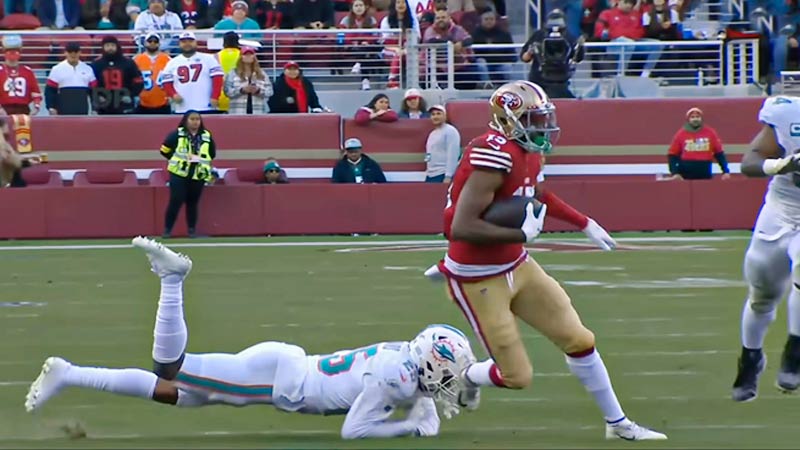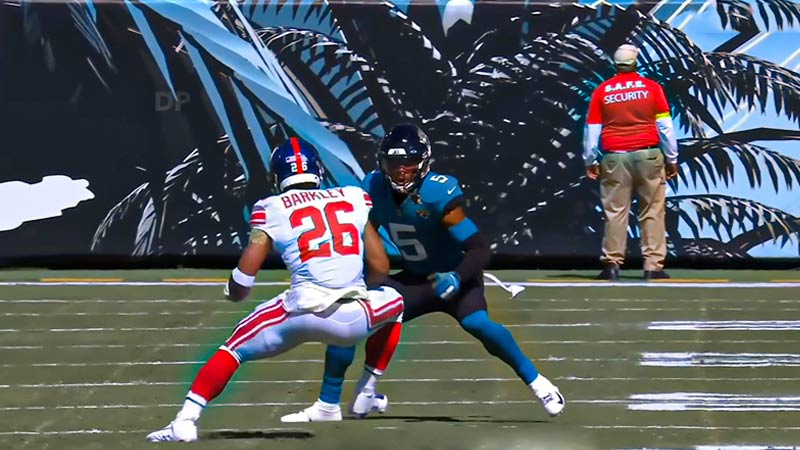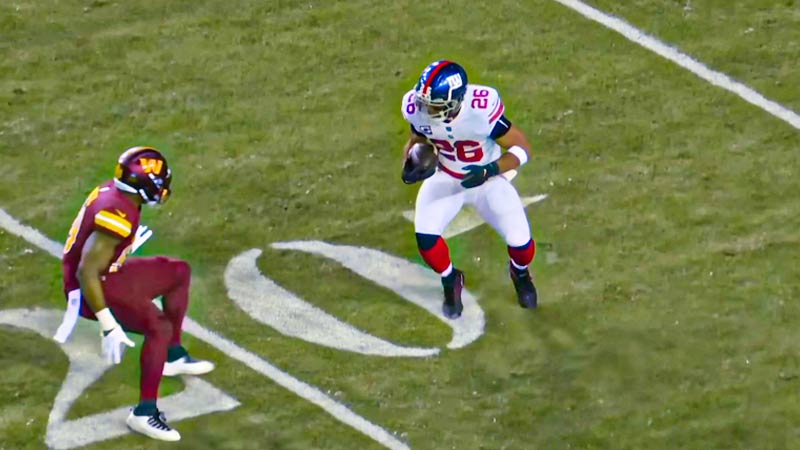In the intricate world of American football, strategies and tactics evolve with each passing season. Among the arsenal of offensive plays lies a dynamic weapon known as the “streak route.”
This play, often a masterpiece of coordination and speed, has intrigued fans and analysts alike. In this blog post, we delve into the depths of football streak routes, uncovering their nuances, strategies, and the art of execution.
Whether you’re a devoted fan, a budding player, or simply curious about the game, read on to demystify the enigmatic world of football streak routes. So, stay focused.
What Is Football Streak Routes?
Football streak routes, commonly referred to as “streaks,” are a popular passing route in American football. Streak routes involve a wide receiver sprinting vertically down the field in a straight line, aiming to outrun defenders and create separation.
This route is designed to stretch the defense deep, forcing defenders to cover a large portion of the field and opening up opportunities for big gains.
Quarterbacks with strong arms often target streak routes for long-distance throws, seeking to connect with the receiver for a deep pass and potential touchdown. Streak routes require precise timing, speed, and coordination between the quarterback and receiver.
While simple in concept, their execution can have a significant impact on the game by exploiting defensive vulnerabilities downfield.
When to Use Stake in American Football?
In American football, the “streak” route, also known as “streaking” or simply a “streak,” is a fundamental passing route that wide receivers run to exploit the defense deep down the field.
It’s a versatile route that can be highly effective when used strategically and in the right circumstances.
Against Man-to-Man Coverage
Streak routes are particularly effective against man-to-man coverage. If a wide receiver is faster than the defender covering them, running a streak can create separation and allow the quarterback to make a long throw downfield.
Exploiting Speed
When a team has a receiver who possesses exceptional speed, streak routes can be used to capitalize on that speed and put pressure on the opposing defense to cover the entire length of the field.
This can force the defense to allocate more resources to deep coverage, potentially opening up other areas of the field for shorter passes.
Clearing Out Defenders
Streak routes can be used strategically to clear out defenders from a certain area of the field. By sending a receiver on a deep streak, it draws the attention of safeties and cornerbacks, creating space underneath for other receivers to operate in.
Play Action and Misdirection
Streak routes can be used in conjunction with play-action passes or misdirection plays.
A successful play-action fake can freeze defenders momentarily, allowing the streaking receiver to get a step ahead of their coverage and giving the quarterback a better chance to deliver an accurate deep pass.
Field Position Advantage
If a team is backed up close to their own end zone, a well-executed streak route can flip the field position in a single play. By stretching the defense vertically, the offense can quickly move into scoring territory, relieving pressure on their own end.
2-Minute Drill
In hurry-up situations, such as the two-minute drill at the end of a half or game, streak routes can be employed to make quick gains and move the offense down the field rapidly. If time is a constraint, streaks can help cover significant yardage in a single play.
Strategies for Executing a Successful Stake

Executing a successful streak route (also known as a “streak”) in American football requires a combination of coordination, timing, and technique. Here are some strategies to increase the chances of executing a successful streak route:
Speed and Explosion
The success of a streak route heavily relies on the receiver’s speed off the line of scrimmage. A quick burst and explosive acceleration can help the receiver create separation from the defender. Working on agility and speed during practice is essential.
Release Technique
A good release at the line of scrimmage is crucial. Receivers should use a combination of moves, such as the “swim” move, “rip” move, or “slap” move, to evade the press coverage and get a clean release. Hand placement, footwork, and body positioning are key aspects of winning at the line.
Timing with the Quarterback
The timing between the quarterback and the receiver is paramount. The receiver needs to time their route so they hit the top speed just as the quarterback releases the ball. This minimizes the time defenders have to react and make a play on the ball.
Maintaining Speed and Focus
Throughout the route, the receiver must maintain their speed and focus while tracking the ball. Any slowing down or looking back too early can give the defender an advantage. Receivers need to keep their eyes on the ball and judge its trajectory accurately.
Body Positioning
As the receiver runs downfield, they should position their body between the defender and the ball to shield the defender from making a play on the pass. This can involve subtle hand-fighting and body positioning to gain an advantage.
Sudden Change of Pace
Towards the end of the route, a well-executed change of pace can catch the defender off guard. The receiver might accelerate slightly to create separation just as the ball arrives, throwing off the defender’s timing.
Maintaining Depth
While the primary objective is to run vertically, it’s important for the receiver to maintain their depth on the field to avoid running out of room along the sideline. This also prevents defenders from forcing the receiver out of bounds.
Reading the Defense
If the receiver notices that they have a significant speed advantage over the defender, they can communicate with the quarterback to signal for a potential deep pass. Reading the defense and adjusting the route accordingly can lead to more successful streak plays.
Communication
Clear communication between the quarterback and the receiver is essential. They should discuss the route, timing, and adjustments before the snap to ensure they are on the same page.
Practice and Repetition
Like any aspect of football, practice is key. Consistently working on streak routes during practice allows the receiver and quarterback to develop a strong rapport and improve their timing and execution.
How to Defend a Steak in Football?

Defending against a streak route (also known as a “streak”) in football requires a combination of solid coverage techniques, anticipation, and strategic positioning. Here’s how to effectively defend against a streak route:
Press Coverage
At the line of scrimmage, a defender can use press coverage to disrupt the receiver’s release and timing. Physical contact and jamming techniques can slow down the receiver’s acceleration and throw off the timing of the route.
Maintain Proper Positioning
As the receiver accelerates downfield, the defender must maintain a position between the receiver and the intended target area. This involves staying on the receiver’s hip and not allowing them to gain a significant advantage in terms of positioning.
Use the Sideline as an Ally
Positioning the receiver towards the sideline can limit their available space to make a play on the ball. This can force the receiver out of bounds or make it more challenging for them to adjust to a deep pass.
Keep Eyes on the Receiver and Ball
The defender should keep their eyes on both the receiver and the quarterback. This allows them to react to any changes in the receiver’s route and anticipate the arrival of the ball.
Anticipate the Throw
As the quarterback releases the ball, the defender should anticipate the trajectory of the pass. This can help them position themselves to make a play on the ball, whether it’s an interception or a well-timed deflection.
Stay in Phase
“Being in phase” means staying close enough to the receiver that you can make a play on the ball if it’s thrown, even if you’re not directly looking at it. This involves using peripheral vision and feels to track the receiver while keeping your body in position to make a play.
Physical Play
While contact beyond five yards is prohibited, defenders can still use physicality within those five yards to disrupt the timing of the route and throw off the receiver’s balance.
Timing the Jump
If the ball is in the air and headed towards the receiver, the defender should time their jump to coincide with the receiver’s attempt to catch the ball. This can lead to a deflection or an interception.
Recover with Speed
If the receiver gains a step or two of separation, the defender needs to quickly recover by using their speed to close the gap. Quick recovery can make it more difficult for the quarterback to complete the deep pass.
Communication
Defenders should communicate with their teammates, especially safeties and other defensive backs, to ensure that coverage responsibilities are well-coordinated and that there are no coverage breakdowns.
Stake Route Variations and Combinations
Football streak routes, known for their explosive vertical sprints downfield, can become even more potent when combined with variations and complementary plays.
Here are some variations and combinations that teams often employ to keep defenses guessing and maximize the impact of streak routes:
Double Moves
Incorporating double moves into streak routes adds an element of deception. The receiver starts with the appearance of a streak, then suddenly breaks off into another route, such as a comeback or an out route.
This can trick defenders who anticipate a deep route, creating separation for a catch and potential yards after the catch.
Slant-and-Go
Combining a quick slant route with a streak route can catch defenders off-guard. The receiver initially makes a sharp cut inside as if running a slant, which prompts the defender to react and potentially commit to defending the short route.
Then, the receiver accelerates vertically for the streak, attempting to capitalize on the defender’s misstep.
Hitch-and-Go
Similar to the slant-and-go, this combination involves a hitch route, where the receiver makes a quick stop a few yards downfield before transitioning into a streak. The sudden stop can make the defender hesitate, creating an opportunity for the receiver to accelerate past them.
Post Streak
A post streak combines a streak route with a post route, where the receiver initially dashes vertically before angling toward the middle of the field. This combination can exploit the separation created by the streak and put the receiver in a prime position to catch a deep pass over the middle.
Play-Action Streak
Using play-action can draw defenders toward the line of scrimmage, creating a clear path for a streaking receiver downfield. The play-action fake can freeze the safeties, giving the receiver a better chance to beat single coverage deep.
Streak with Crossing Routes
Combining a streak route with crossing routes by other receivers can create confusion in the defense’s coverage. The streaking receiver draws attention downfield, potentially opening up spaces for other receivers crossing underneath.
Flood Concepts
Flood concepts involve sending multiple receivers to different areas of the field, forcing defenders to cover multiple zones. Combining a streak route with flood concepts can isolate a defender on the streaking receiver, exploiting potential one-on-one matchups.
Four Verticals
In this play, all four eligible receivers run deep routes vertically down the field. One of these receivers might execute a streak route, while the others run variations like seam routes or corner routes. This play stretches the defense to its limits, creating opportunities for receivers to find open areas.
Wheel Route
A wheel route is a combination of a streak route and an out route. The receiver initially runs vertically before breaking toward the sideline. This can exploit mismatches with slower linebackers or safeties who struggle to cover the receiver’s change of direction.
Streaks with Screens
Pairing a streak route with a screen pass to another receiver or running back can create confusion in the defense. As defenders move to cover the streak, the screen can exploit open spaces and blockers downfield.
Successfully incorporating these variations and combinations requires precise execution, well-timed play calls, and a deep understanding of defensive tendencies.
FAQs
What exactly is a football streak route?
A football streak route, often referred to as a “streak,” is a deep passing route where a wide receiver sprints vertically down the field in a straight line. This high-speed route aims to outpace defenders and stretch the defense, creating opportunities for long-distance throws and potential touchdowns.
When is the streak route commonly used?
Streak routes are a go-to choice when a team aims to exploit a speed advantage or catch the defense off-guard. They’re particularly effective against man-to-man coverage, and they find a place in scenarios like the two-minute drill, where quick yardage is needed to advance downfield rapidly.
How is a successful streak route executed?
Executing a successful streak route involves a combination of factors: explosive speed off the line of scrimmage, precise timing between the quarterback and receiver, maintaining depth on the field, and maintaining focus on tracking the ball while using body positioning to shield defenders.
What are the challenges of defending against streak routes?
Defending against streak routes demands anticipation, strategic positioning, and effective communication among defensive players. The defenders need to maintain proper coverage techniques, anticipate the trajectory of the pass, and recover quickly if separation occurs.
Can streak routes be effectively countered by defenses?
Yes, defenses can counter streak routes by employing techniques such as press coverage at the line of scrimmage, maintaining proper positioning to disrupt timing, and mixing up coverages to keep the offense guessing.
Effective communication among defenders and studying opponents’ tendencies also play a vital role in countering streak routes.
Wrapping Up
In the world of American football, streak routes stand as a testament to the sport’s strategic complexity and the fusion of athleticism and precision.
From the explosive takeoff to the suspenseful anticipation of a perfectly timed pass, the streak route embodies the exhilarating essence of the game.
Whether celebrated for its spectacular success or thwarted by a well-coordinated defense, the streak route remains an integral part of football’s captivating narrative, ensuring that each play carries the potential to alter the course of a game. Best wishes.







